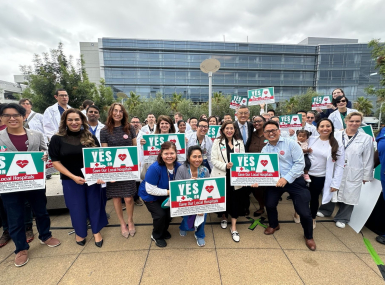SAMHSA releases new 2024 data on rates of mental illness and substance use disorder in the U.S.
Author

Blaire Bryant

Naomi Freel

Emily Steckler
Upcoming Events
Related News
Key Takeaways
On July 28, the U.S. Department of Health and Human Services’ (HHS) Substance Abuse and Mental Health Services Administration (SAMHSA) released the findings of its annual National Survey on Drug Use and Health (NSDUH), which provides data on rates of substance use and mental illness at the national, state and local level. This recent report demonstrates critical data from 2024 that can be used by county health and mental health services administrators and local policy makers as they work together to understand and address the ongoing behavioral and mental health crises in America.
Key survey findings
- 16.8 percent of the U.S. population aged 12 or older (about 48.4 million individuals) met the criteria for a substance use disorder (SUD). This is similar to the 2023 report when 17.1 percent of the population (around 48.5 million people) reported a SUD.
- 23.4 percent of adults aged 18 or older (about 61.5 million people) experienced any mental illness (AMI), with about 5.6 percent reporting a serious mental illness (SMI). Comparatively, 22.8 percent (58.7 million people) and 5.7 percent (14.6 million people) of adults reported AMI and SMI, respectively, in 2023.
- Among the approximately 61.5 million adults who experienced AMI in 2024, 31.5 percent also met the criteria for a SUD, whereas in 2023, 33.3 percent of adults who reported AMI had a SUD.
- 15.4 percent of adolescents aged 12 to 17 (about 3.8 million individuals) reported experiencing a major depressive episode (MDE). This is a slight decrease from 2023 where 18.1 percent of adolescents (around 4.5 million individuals) reported a MDE.
- For the first time, the 2024 NSDUH included measures of generalized anxiety disorder (GAD). The results showed:
- 21.7 percent of U.S. adults (over 1 in 5 individuals) reported symptoms of GAD with 7.4 percent reporting moderate or severe symptoms and 14.3 percent reporting mild symptoms
- Rates of GAD were higher among adolescents, with 41.9 percent (over 4 in 10 adolescents) experiencing symptoms, including 18.8 percent who reported moderate or severe and 23.1 percent who reported mild symptoms.
Additional findings from the 2024 NSDUH include:
- Slight decline in suicide attempts and deaths among adolescents aged 12 to 17: The number of adolescents who had serious thoughts of suicide in the past year decreased from 3.2 million (12.3 percent) in 2023 to 2.6 million in 2024 (10.1 percent). Among those who experienced serious thoughts about suicide in 2024, around 2.7 percent (approximately 700,000 people) attempted suicide.
- Trends in opioid use disorder remained stagnant: In 2024, 1.7 percent of those aged 12 or older (around 4.8 million people) had an opioid use disorder, which aligns with previous years.
- Significant lack of access to substance use treatment among individuals aged 12 or older: Of the 18.2 percent of individuals (52.6 million) who needed substance use treatment in 2024, only 3.5 percent (around 10.2 million individuals) received treatment. Additionally, 4.4 percent of adults (1.8 million) and 6.7 percent of adolescents (111,000) with a SUD who did not receive treatment thought they should have been able to. Common reasons for not receiving treatment include stigma around treatment, cost, lack of knowledge of resources and insufficient health insurance.
County impact
As the ongoing behavioral health crisis is addressed in counties throughout the country, NACo remains dedicated to advocating for the passage of key county priorities that support behavioral health systems and provide pathways to treatment for individuals with mental illness and SUD. NACo’s key policy priorities are outlined in the recently updated report, Top 10 County Policy Priorities for Behavioral Health Reform.
Resource
Top 10 County Policy Priorities for Behavioral Health Reform

Related News

CMS issues new guidance on Medicaid Community Engagement Requirements
On December 8, the Centers for Medicare & Medicaid Services (CMS) released a Medicaid and CHIP Services Informational Bulletin (CIB) directing states on how to implement the Medicaid community engagement requirements enacted under Section 71119 of the One Big Beautiful Bill Act legislation (Public Law 119-21), or H.R. 1.

California county sales tax measure backfills federal healthcare cuts
Santa Clara County, Calif. will raise an estimated $330 million each year from a sales tax to backfill lose Medicaid funding.
